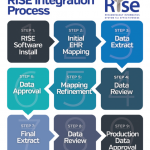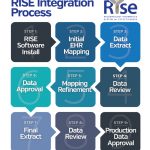RISE will also be able to give providers the maximum 11 bonus points in the Quality category. Six points come from what is known as the end-to-end bonus, because all measures are electronically extracted, and providers will receive two points for an additional outcome measure and one point for each additional high-priority measure.
Clinical Practice Improvement Activities (CPIA)
This category consists of 90 activities that practices will complete through attestation. Of these 90 activities, practices will attempt to reach a score of 40 points with activities weighted differently. There are two weights for scoring under CPIA: medium = 10 points and high = 20 points. Providers will have to attest that they have completed these activities for a minimum of 90 days. If you are considered a small practice (15 providers or fewer), you will only be required to complete half of the points (20 points).
Participation in a QCDR registry, such as RISE, allows you to collect 30 points immediately through two population-management activities:
- Use of a QCDR to generate regular performance feedback that summarizes local practice patterns and treatment outcomes, including for vulnerable populations.
- Weighting: high; 20 points
- Participation in a QCDR, clinical data registries or other registries run by other government agencies, such as the FDA, or private entities, such as a hospital or medical or surgical society. Activity must include use of QCDR data for quality improvement (e.g., comparative analysis across specific patient populations for adverse outcomes after an outpatient surgical procedure and corrective steps to address adverse outcome).
- Weighting: medium; 10 points
For a full list of CPIAs, visit the CMS website.
Advancing Care Information (ACI)
This category will largely be dependent on the individual practice’s electronic health record (EHR) system. By participating in a QCDR like RISE, you are eligible for a 5% bonus in this category.
You will have to complete one of two options for ACI:
- Advancing Care Information Objectives and Measures
- 2017 Advancing Care Information Transition Objectives and Measures
How far your practice was along in Meaningful Use will determine which of two pathways you will take to satisfy this category:
You can report the Advancing Care Information Objectives and Measures:
- If you have technology certified to the 2015 edition; or
- If you have a combination of technologies from 2014 and 2015 editions that support these measures.
You can report the 2017 Advancing Care Information Transition Objectives and Measures:
- If you have technology certified to the 2014 edition; or
- If you have technology certified to the 2015 edition; or
- If you have a combination of technologies from 2014 and 2015 editions.
Resources for 2018 Readiness

